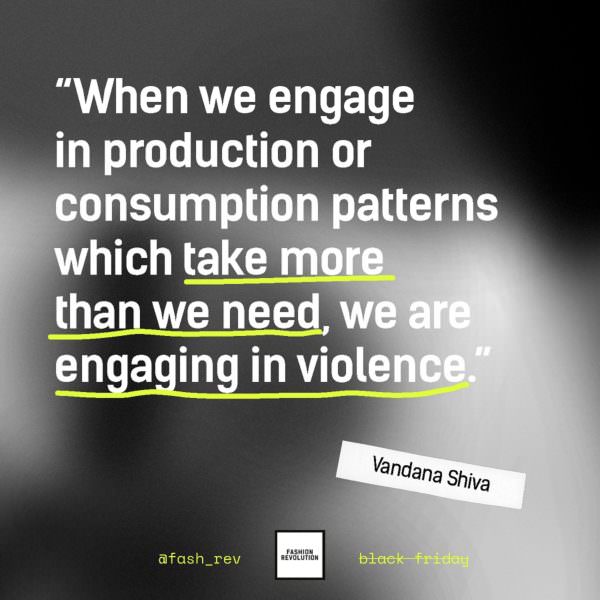
How To Make Black Friday More Sustainable
Black Friday is nearly upon us. On this popular shopping day in 2021, U.S. shoppers spent $6.6 billion, an increase of 29.8% over 2020. Combined with Cyber Monday and Super Saturday, which bring businesses even more revenue, consumer holiday spending is expected to skyrocket in 2022.
Altogether, our simple holiday purchases have huge consequences. The frenzy of consumerism drives waste, emissions, and exploitation of resources and overseas workers.
Encouraging shoppers to spend time outside instead of shopping, outdoor retailer REI closes its stores on Black Friday and Patagonia no longer runs Black Friday sales on its website, urging shoppers to buy less. Similarly, organizations like Fashion Revolution strive to disrupt the Black Friday waste cycle through “digital protests” that rely on shareable social media assets, such as the image below, to advocate against overconsumption.
You can help by spreading the word online, approaching your holiday shopping more sustainably, or finding an alternate way to give this holiday season.
The Negative Impact of Black Friday
Items commonly purchased on Black Friday include electronics and tech gadgets, toys, and clothing. While we love the holidays as much as the next person, it’s necessary to ask: What happens to all of those purchases after the first thrill fades away?
The answer is simple. Most of it becomes waste.
Overconsumption has an enormous human toll, perpetuating unsafe working conditions, extreme poverty, and political instability/war in producing countries.
While consumerism has consequences in the best of times, they are amplified in the high-volume shopping season starting with Black Friday. A sustainability mindset means thinking about every single purchase we make. Try these facts on for size:
Raw Materials
Packaging Waste
- U.S. landfills received 32.1 million tons of containers and packaging (23% of total landfilling) in 2017.
- Globally, only 9% of plastic is recycled. Some is downcycled into clothing that, if not recirculated, is then landfilled.
- Americans use 100 billion plastic and 10 billion paper bags per year. Receipts cannot be recycled because they contain harmful chemicals.
Gift Wrap Waste
- In 2017, Americans spent $12.7 billion on gift wrap (wrapping paper, tissue paper, and gift bags).
- Conventional gift wrap is not recyclable and usually heads straight to the landfill after one use.
- Glitter wrap, which includes small plastic microparticles, is particularly harmful.
Shipping Emissions
- Online sales have a huge environmental impact: Shipping makes up approximately 3.1% of annual global CO2 emissions.
- The U.S. Postal Service delivers hundreds of millions of packages between Thanksgiving and New Year’s Day.
- Transportation is the #1 producer of carbon emissions and nearly a quarter of those emissions come from delivery trucks.
Conscious Companies: Current Incentives
Black Friday is known for its deals and discounts, but psychologically we associate cheap products with low value. As a result, we are more likely to see what we buy today as easily disposable tomorrow and by extension, we devalue the resources and human capital that put them in our shopping carts.
“Companies won’t change unless consumers push them to, but the problem has to do with our addiction to consumption,” GFX founder Patrick Duffy said.
Unfortunately, false sustainability claims, known as greenwashing, confuse people while exacerbating the problem. For example, Zara and H&M have committed to sustainable materials while IKEA has launched a buy-back program to encourage a more circular business model. The problem? Neither initiative addresses the root of the problem: overconsumption.
For now, consider supporting companies that:
- Abandon Black Friday as retailers Marks and Spencer and Raeburn already have. They all promote a #BuyNothingDay hashtag as an alternative to Black Friday sales.
- Donate profits like Pukka Herbs, which has given 100% of Black Friday profits to charity, or Everlane, which has donated $10 from every order to help end single-use plastic
- Give back like Patagonia, which has encouraged customers to donate to environmental nonprofits in the name of a loved one
- Close their stores entirely, like REI
How To Be a Conscious Consumer
Part of being a conscious consumer is knowing you can choose to not consume at all. Not buy holiday presents, you ask? Not necessarily. Start with a mindset shift to measure gifts based on their thoughtfulness, not cost:
- Experience gifts like tickets to online events, e-books, gift cards for a favorite restaurant or massage
- No-plastic gifts like bamboo cutlery and glass or ceramic dishware
- Edible gifts like a bottle of wine or homemade jam
- Re-gifting (there’s nothing wrong with it!) or gifting forward your old electronics, toys, and clothing to keep them in circulation longer
Tie up your presents with zero-waste gift wrapping that you can collect throughout the year from reusable, fully recyclable, or compostable materials, including burlap bags, newspaper, scrab fabric, vintage jewelry, real tree branches … the possibilities are endless.
Whatever you do, don’t fall for the deceptive marketing of “compostable” or “biodegradable” plastic that is worsening the plastic pandemic.
As for the gifts people will give you, why not bring back the tradition of writing to “Santa” and let your circle know exactly what you want?
For shopping trips, make a list ahead of time to help you stick to pre-planned purchases and so, reduce potential waste. Bring plenty of reusable bags in varying sizes and skip the receipt or send it to email.
Also, consider giving your time rather than gifts this year. Contact local soup kitchens and food pantries, senior homes (some may have virtual programs in place), and homeless shelters to give your time to the less fortunate and enrich your life at the same time.
Originally published on November 23, 2020, this article was updated in November 2022.
<!–
You Might Also Like…
–>

